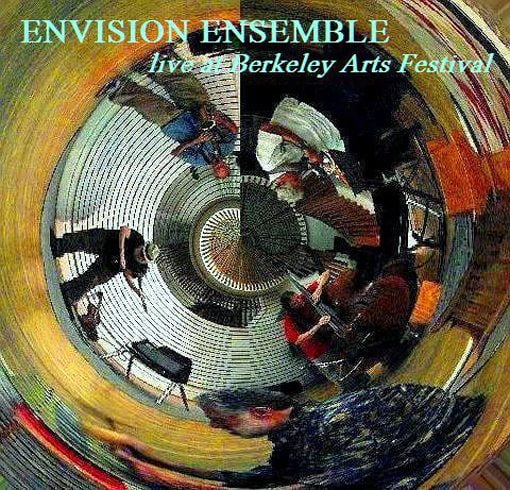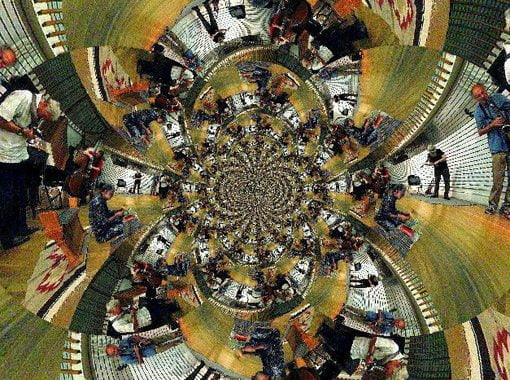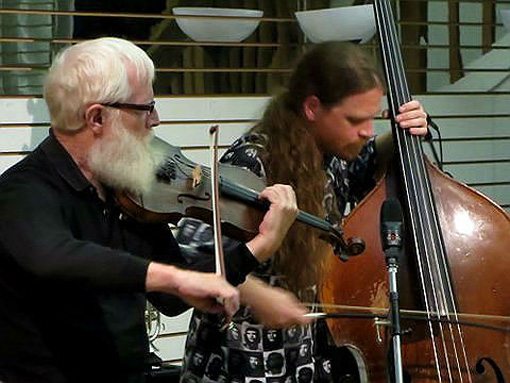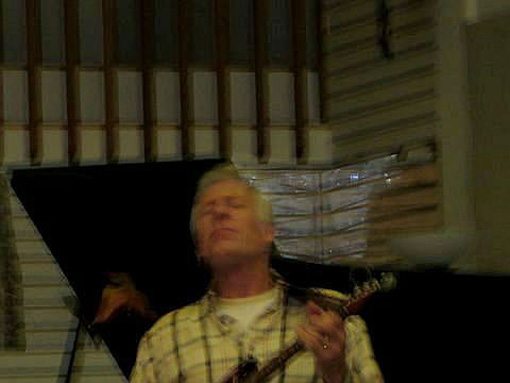
ECHO ECHO MIRROR HOUSE Music
Implications for Improvisation
I’ve heard a lot of music over a lot of years, so it takes a sonic jolt of sorts to get me writing these days. Two extraordinary new releases from Anthony Braxton provided the jolt:
Echo Echo Mirror House (Septet Victoriaville) 2011: Composition 347+ (Victo CD 125)
Taylor Ho Bynam/ cornet, bugle, trombone, ipod, Mary Halvorson/ guitar, electric guitar, ipod, Jessica Pavone/ alto, violin, ipod, Jay Rozen/ tuba, ipod, Aaron Siegel/ percussion, vibraphone, ipod, Carl Testa/ contrabass, bass clarinet, ipod, Anthony Braxton/ alto, soprano & sopranino saxophones, ipod, direction & composition.
Recorded: May 21, 2011at Festival Musique Actuelle de Vicoriaville, Canada.

Echo Echo Mirror House (NYC) 2011 Composition 367 (NBH 035, download from TricentricFoundation.org)
Anthony Braxton, Andrew Raffo Dewar, James Fei, Steve Lehman, Chris Jonas, Sara Sschoenbeck/ reeds, Taylor Ho Bynam, Reut Regev, Jay Rozen/ brass, Renee Baker, Erica Dicker, Jessica Pavone/ strings, Mary Halvorson/ guitar, Carl Testa/ bass, Aaron Siegel/ percussion.
Recorded: October 7, 2011 live at Roulette, New York.
These releases document the first recorded examples of Braxton’s new Echo Echo Mirror House music. Following on the heels of his advanced Ghost Trance Music (see review by clicking here please…), in which players instrumentally access and include in their compositional renderings any of Braxton’s music from whatever period, in this new Echo Echo Mirror House music the players – in addition to their acoustic instruments – wield IPODs loaded with digitized versions of Braxton’s entire recorded output: the players can instantly access any of Braxton’s recorded music from any period and interject that music over an array of loudspeakers into the new EEMH compositions.
The compositions themselves include no written music. The players are provided with copies of maps that might be linked to anything, like say, NY’s subway system, or highways along the northeastern corridor; superimposed on the maps are graphic elements illustrating how the players might interpret their maps; the players are additionally provided with a set of instructions (“turn north, turn south…take longest route possible…turn to left”, and so on) about how to sonically navigate the cartographic pictorials. Each musician is free to make his or her own interpretation of the piece’s abstract parameters and to proceed through the instructions at their own pace.


What does the Echo Echo Mirror House music sound like? To begin with, there are no predetermined openings, so each player begins playing or extracting from their IPODs whatever they like. The whole sounds like an auditory version of those riotously outrageous all over the place light shows that used to accompany music in the 60s. You might think of it as an expansive, hydra-headed sonic menagerie inside of a refractive carnival funhouse!
The music’s impact is initially jarring, as it turns on its head any number of assumptions about how music is supposed to work and transpire. Not that Braxton hasn’t already been traveling down this road – he’s been actively putting forth the idea of all of his music being played and heard together since at least the early 1980s, and he’s been pursuing more and more complex versions of that idea ever since. But the Echo Echo Mirror House music pushes the envelope of that concept to a level not previously heard or imagined.
One online blogger has already likened the impact of the EEMH to that of Coltrane’s 1965 Ascension (Impulse), that beautifully wild and shattering musical outpouring some people are still striving to understand. There’s some truth to that, but an aural antecedent for this music might more readily be found in Marion Brown’s 1970 under-appreciated masterpiece Djinji’s Corner (Side B of Afternoon of a Georgia Fawn, ECM), on which Braxton is one of the players. In that piece, the players engage in what Brown calls “interchangeable discourse”; each musician moves from one “musical station” to another, each station consisting of “primary”, “secondary”, and “miscellaneous” instruments. At each station, the players remain just long enough (a minute or so) to set up a musical phrase on an instrument of choice, then they move on. In the course of the piece, lasting 18 minutes, Brown notes that “there are seven players and seven stations which means there are 49 themes played.”
The effect is not unlike that of the EEMH pieces, though I wouldn’t care to speculate as to how many themes or independent phrases might be heard in the course of these two 60-plus minute compositions.

There are also significant differences between the two EEMH works. Composition 347+ is, like Djinji’s Corner, played by a septet. There is a good deal of clarity in the recording, and easily identifiable thematic references abound. Live instrumental input can at least at times be heard as separate from recorded interjection.
Composition 376, on the other hand, is played by 15 players (the “12+3 tet”), including 5 reed players, 3 brass players, and 3 string players together with guitar, bass, and percussion. The organized and surprisingly organic cacophony is considerably denser on this piece, and it is more difficult (at least for me) to locate actual thematic material. At times I hear what I think are passing thematic allusions, but the IPOD interjections seem much more abstract in their references than on Composition 347+; either that, or much of the interjected material may be taken from other recent works of Braxton’s not based on thematic material at all (like his Diamond Curtain Wall Music or his Falling River Music, each of which uses graphic scores to orient the players). The whole is like a sonic shape-shifting textural mass within which any number of live and/or recorded instrumental voices darts about in high relief. As a reference, NY Eye and Ear Control (ESP) kept coming to mind as I listened to this piece; or maybe it just sounds at times like an unkempt and rowdy free jazz blowout! And, speaking of Ascension, around the 48th minute, someone plays a vague Ascension-like theme that a number of players pick up on and one part of the music moves into a liquid mix of long lines and colors pushing into and out of each other.
Due to its increased level of abstraction, Composition 376 allows one to more easily hear the form of this music as pure form; i.e. beyond simply a form bearing the overpowering stamp of Braxton’s music. So suppose we were to extend this form to include recorded interjections of some other music (say, Charlie Parker’s music, or Coltrane’s music, or whoever’s music) or any music or all music or maybe even all sounds! Copyright considerations aside, there’s no end of possibilities. But it would seem that, whatever the inclusions, there’s going to be an overriding point of diminishing returns. What happens, say, when these pieces and pieces like them – which to a large extent are built on the sampling of previously recorded pieces – are themselves the main source for new sampling? Eventually it seems like a sound threshold will be reached, and we will have before us some kind of new Noise Music; or there will be something like a reverse “Big Bang” and everything will simply revert to Silence. But, of course, these two possibilities – Noise, and Silence (or at least a “Not-Music” tending toward Silence, based on Japanese onkyo) – are already full-blown musical movements, co-existing in time and space with the Echo Echo Mirror House music.
All this got me thinking about form in general and how formal change or evolution takes place in purely improvised music. That is, how form changes without a composer to give direct impetus to the change.
Many an unspoken assumption is at work regarding how players “listen” to each other in group improvisation situations and what levels of abstraction or complexity, or of noise or silence, they are going to pursue. Players carry with them quite similar imprints about how they are going to relate to each other and about what good relating is. To varying degrees, the players attempt to mimic, match, re-frame, re-phrase, oppose (as an opposite manner of “matching”) and interweave with the creations of their fellows.
A wide range of players has become quite good at this manner of improvising. There’s nothing wrong with this, but the truth is – as we are all aware – much improvised music has lost its edge and become overly predictable in its manner of working.
With its ongoing, changing and simultaneous multiple levels of activity, the EEMH music shifts the foundation upon which those imprinted assumptions about how players ought to relate is based. In a Downbeat interview from March 2012, quoted in the notes to Composition 347+, Braxton explains: “With the ‘Echo Echo Mirror House’ musics, we’re redefining the concept of elaboration. It’s not a linear elaboration. The new models are multi-hierarchical formal states that allow for many different things to happen at the same time…’” Perhaps, then, the EEMH music can provide a nudge in the direction of new ways of improvisational thinking.
So how, in the best of worlds, does a vital free-improvised music work and how does form evolve?
It so happens that at the same time I was listening to Braxton’s new EEMH music, I received a copy of Evan Parker’s newly released solo performance Vaincu.Va!, recorded live at Vancouver’s Western Front on November 8, 1978. This performance came only six days after Parker’s stunning solo presentation at Woody Woodman’s Finger Palace in Berkeley, California (Evan Parker at the Finger Palace, The Beak Doctor 3), a performance I attended and reviewed in my newsletter BELLS).

Vaincu.Va!
Evan Parker/ soprano saxophone
Recorded: November 8, 1978 at Western Front, Vancouver BC
What’s interesting is that while Parker’s saxophone language at the Western Front is not unlike that used at the Finger Palace, the performance itself along with its sense and feeling is completely different.
At the Finger Palace, Parker’s playing moves at a measured pace throughout. It begins by mimicking electronic sound sources, then sets up and swings off a series of shifting rhythmic fulcrums until Parker stands like a Native American shaman at the center of an extremely high-pitched electrical sound field. Then there’s a re-grouping, re-shifting, and an extended exploration of quick rhythmic sound clusters that by the end of the performance is simultaneously firing out crackling electrical currents. The performance lasts some 45 minutes, Parker’s longest single solo presentation.
At the Western Front, the music begins at an extraordinary level of intensity and complexity. While operating from a similar rhythmical base as at the Finger Palace, Parker’s lines in the first few minutes herald the more compact multi-linear expression of his later solo work. (Hear Lines Burnt in Light, Psi, October 2001, for example.) The intensity level continues for nearly half the performance before there begins a kind of deconstruction and reconstruction of the music’s component parts. The performance, every bit as compelling as that at the Finger Palace, lasts around 34 minutes.

Evan Parker 1978 @ Western Front – Image by Kate Craig
Of course, we can now see these as something like transitional recordings of Parker’s solo music, but the performances are complete in themselves. They are based on Parker’s thoroughgoing reinvention of saxophone language, a language that did not exist prior to his creating it.
What is interesting formally about these performances is Parker’s willingness to allow his playing to adapt to its immediate surroundings and to allow it to feint and flow inter-dimensionally, i.e. to play from known dynamically-evolving source rather than from habituation.
But how does improvised music evolve as group music? In the first instance, it evolves – like Parker’s solo music – out of expanded instrumental language which itself comes about from players’ willingness to risk unknown dimensional leaps – i.e. to stay fully in the process of the music while trusting in its outcome. I think back to Topography of the Lungs (Incus), 1970, and why that was such a ground-breaking recording. The formal bounds of improvisation were shattered by three players (Parker, Bailey, Bennink) who had completely reinvented the languages of their instruments. So how could the players have responded to each other in ordinary ways? It would not have been possible.
Along with new ways of playing instruments, the introduction of new instruments – like electronics or electronic processing – out-of-culture instruments, or newly invented instruments can move improvisers’ formal relations in new directions; also, added complexity within what are known processes (for example, Parker-Guy Lytton Zafiro, Maya, 2006); or players’ collaborations with musicians with whom they might not ordinarily play (I think of Derek Bailey’s later work, like his recording Mirakle, Tzadik, with longtime harmelodic masters Jamaaladeen Tacuma and Calvin Westin; or his amazing live recording with Pat Metheny, Gregg Bendian, and Paul Wertigo: disc 1 of The Sign of 4, Knitting Factory Works, 1996).
Yet while each of these ways of formal evolution can work to change the content and shape of improvisers’ playing, none necessarily changes the way in which improvisers actually relate to each other. That takes more of an evolution of consciousness and of a conscious awareness of felt reality, what players find of emotional weight and interest at any given moment and the state of the players’ own nervous system (as both a reflector and artistic imaginer of the societal nervous system).
So credit is due Anthony Braxton for having rescued a good deal of contemporary music from the doldrums and for having pointed some new directions forward. His much-acclaimed quartet music of the 1980s and 90s came along just when the jazz quartet was in need of an infusion of energy and direction. His advanced GTM music and now his new Echo Echo Mirror House is rethinking and reinventing the ways in which players relate to music itself. As for the future… well, you might have a look at his Sonic Genome project on his tricentricfoundation.org website.
There’s obviously more to come!
Henry Kuntz – August 2013
All Rights Reserved




























